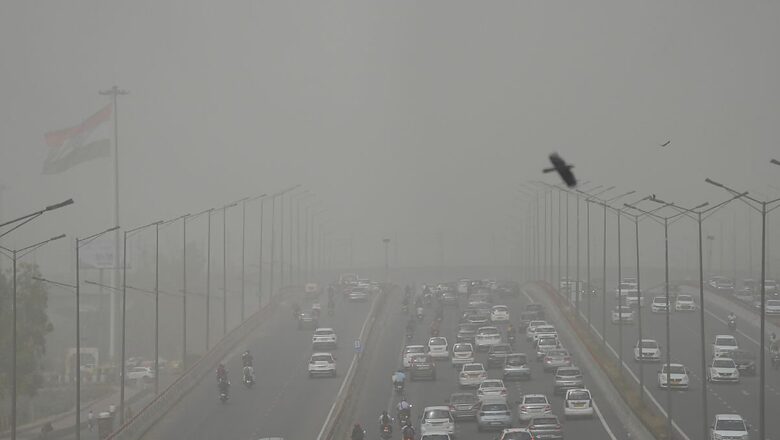
views
Delhi’s 24-hour average air quality index stood at 248, which is categorised as ‘poor’, on Saturday and is likely to worsen and enter the ‘very poor’ (301 and 400) category on October 23 and 24. In view of this, the central government invoked measures under stage II of the ‘Graded Response Action Plan’, or GRAP, which is implemented in Delhi-NCR to combat rising air pollution levels in the winter season.
The minimum temperature, meanwhile, settled at 15.8 degrees Celsius, three notches below the season’s average, while the relative humidity was recorded at 83 percent, as per the India Meteorological Department (IMD). Despite a prediction of mainly clear skies during the day, the air quality was ‘poor’ at 219 around 9 am and deteriorated into the evening.
An AQI between zero and 50 is considered ‘good’, 51 and 100 ‘satisfactory’, 101 and 200 ‘moderate’, 201 and 300 ‘poor’, 301 and 400 ‘very poor’, and 401 and 500 ‘severe’. GRAP also categorises actions into four stages: Stage I ‘poor’ (AQI 201-300); Stage II ‘very poor’ (AQI 301-400); Stage III ‘severe’ (AQI 401-450); and Stage IV ‘severe plus’ (AQI >450).
Data collected also shows that this October is proving to be the most polluted since 2020, when the national capital’s air quality was much improved owing to the Covid-induced lockdown.
Here is all you need to know how Delhi will combat air pollution this season under Stage II of GRAP:
- The Commission for Air Quality Management (CAQM), a statutory body responsible for proactively implementing GRAP, held a meeting to review the air quality situation in Delhi-NCR. It presented forecasts by the IMD and the Indian Institute of Tropical Meteorology (IITM), which suggest Delhi’s overall air quality is likely to dip and enter the ‘very poor’ category on October 23 and 24, owing to unfavourable meteorological and climatic conditions.
- Due to this, measures under Stage II of GRAP will be invoked in Delhi-NCR in addition to steps already taken under Stage I. “All actions as envisaged under Stage II be implemented in right earnest by all the agencies concerned in NCR with immediate effect, in addition to all Stage I actions of GRAP already in force,” the CAQM said in an order.
- The Centre’s air quality panel directed NCR authorities to increase parking fees so that people do not use their private vehicles and, instead, commute by public transport for which CNG or electric bus and metro services will be enhanced.
- The National Green Tribunal (NGT) has issued notices and sought action-taken reports from several authorities, including the Delhi chief secretary, environment ministry and Municipal Corporation of Delhi, in a matter regarding the deteriorating air quality. Suo motu proceedings were based on media reports on the deterioration in air quality and violations of GRAP.
- The NGT bench hearing the matter said despite action taken, the problem of air pollution is aggravating in Delhi and the residents are facing health problems due to it. “We deem it proper to implead the following authorities in the matter — chief secretary, Delhi, member-secretary, Delhi Pollution Control Committee (DPCC), commissioner, Municipal Corporation of Delhi (MCD), member-secretary, Central Pollution Control Board (CPCB) and the Union Ministry of Environment, Forest and Climate Change (MoEF&CC). Let notice be issued to the aforesaid respondents,” the tribunal said in an order passed on Friday (October 20).
- Action-taken reports have to be filed about controlling air pollution from different sources in Delhi as per GRAP so as to maintain the AQI in an acceptable range to safeguard public health. The matter has been listed on November 8 for further proceedings.
- Till October 15, Delhi traffic police has issued more than 1.5 lakh challans to vehicle owners driving without pollution under control certificates (PUCC). A total of 1,58,762 challans were issued till October 15, which is 50,662 more than the number of challans issued during the same period last year.
- The maximum number of challans were issued in Daryaganj circle (6,306), followed by Sarita Vihar (6,254), Rajouri Garden (5,595), Shahdara (5,442) and Tilak Nagar (5,252). Highest number of challans were issued to motorcycle riders at 69,190, followed by scooter riders (49,219), car drivers (33,754) and autorickshaw drivers (1,556).
(With PTI inputs)




















Comments
0 comment